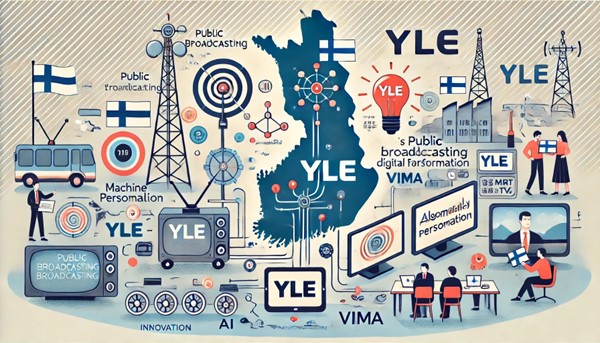In this piece
How Finland's public broadcaster cornered the local streaming market

More popular than Netflix in Finland, YLE's approach to digital transformation may hold lessons for public broadcasters everywhere. Image: Generated by Dall·E
In this piece
Digitalisation of public broadcasting in Europe | Conditions for Areena’s success | Stable financial resources | Content strategy and copyright management | Customer experience as the bedrock of a unified platform | New initiatives in news reporting | Coexisting with Commercial Media | Stay innovative | ConclusionThe digital revolution has reshaped journalism, pushing public broadcasters worldwide to redefine their roles. While many have transitioned from traditional TV stations to digital media, they still face intense online competition, declining influence, and resource constraints.
Despite the shift to a post-broadcast world, many broadcasters continue to operate primarily as traditional broadcasters. As an employee of NHK, I embarked on a project to find the best practices for navigating this change.
During my time at the Reuters Institute for the Study of Journalism, I found inspiration in Finnish public broadcaster Yle, which has successfully embraced digitalisation while maintaining strong public support.
Digitalisation of public broadcasting in Europe
The digitalisation of public broadcasting in Europe began in the mid-2000s, with the BBC and Yle leading the way. A survey by the Reuters Institute found that, while TV and radio news reach was high across six European countries, only Finland and the UK also had high online reach.
The study identified three areas where the BBC and Yle excelled: organisational reform, mobile distribution, and social media use.
Four key conditions contributed to their success:
1. Integrated and centrally organised public service media.
2. Relative isolation from political influence.
3. A culture viewing new media as an opportunity.
4. Leadership advocating continuous organisational change.
For Yle, the heart of its digitalisation is the Areena streaming platform. Available as a mobile app, web browser, and on Smart TVs, Areena provides access to a vast array of content, including TV shows, movies, podcasts, and live broadcasts. This seamless content provision has made Yle an essential part of Finnish citizens’ daily lives.
Conditions for Areena’s success
Yle’s transformation into a digital powerhouse is a case study in successful adaptation. Key to this success was the early development of Areena in 2006, at a time when YouTube was just launching, and broadband was not widespread.
This foresight came from top management, particularly Chairman Arne Wessberg, who initiated projects to make Yle’s past programmes available online.
Successive leadership also played a crucial role. Mikael Jungner, who succeeded Wessberg, continued to drive digital transformation, emphasising a flat organisational culture that enabled rapid decision-making and the incorporation of younger generations' technological interests.
This environment allowed its product developers on the New Services team, led by Jari Lahti, to operate like a start-up within a bureaucratic organisation.
Recruiting digital specialists was also essential for Yle’s reform. Lahti had backing from the Board of Directors to make organisational changes and hires to transform Yle into a digitally adept organisation, highlighting the importance of top management’s trust in the New Services team.
Stable financial resources
Another critical factor was Finland’s transition from TV reception fees to the Yle tax in 2013. This change, prompted by a flaw in the subtitling system, provided stable financial resources and freed Yle from the constraints of traditional TV broadcasting. The introduction of the Yle tax allowed Areena to release content without prioritising terrestrial TV broadcasts.
Content strategy and copyright management
Yle’s new strategy positions the Areena streaming service and news sites at the top, with TV and radio below. Early and proactive management of copyright issues has been a significant advantage, contrasting with the BBC’s struggles with regulatory delays.
Customer experience as the bedrock of a unified platform
To deliver personalised content, Yle established a customer experience department in 2016, led by Jaakko Lempinen. This department analyses metadata to develop algorithms that tailor content to individual viewers' preferences. As of 2020, Yle’s unified site offers 100,000 pieces of content, requiring dynamic personalisation to engage viewers effectively.
Lempinen’s team considers three core audience groups: the younger generation, who are autonomous media users; those who grew up with traditional media but now rely on digital services; and loyal customers accustomed to VIP-levels of service. Balancing change with producing content that appeals to all groups is crucial for retaining public value.
New initiatives in news reporting
Alongside Areena, Yle launched Uutiset, a site dedicated to daily news coverage. Executive online producer Timo Kämäräinen leverages audience data to shape new digital content. One innovation was the rollout of morning and evening briefs via push notifications, delivering major news stories in a visually appealing format.
Reaching younger audiences is vital. Yle is developing an offering for Generation Z, featuring video-rich content and collaborations with popular influencers. This approach, used by Germany’s ZDF and ARD, needs testing in different markets to gauge acceptance.
Coexisting with Commercial Media
Yle’s success has led to accusations of monopolisation from corporate media. In 2017, commercial media lobbyists petitioned the EU Commission to restrict Yle’s text content to video and audio. In 2021, Sanoma complained to EU authorities about Areena’s content. Yle’s chief executive Merja Ylä-Anttila argued that weakening Areena would harm Finnish media users and benefit large international platforms.
Yle’s dominance in the podcast market also prompted a study by the University of Jyväskylä, concluding that Yle must take action if it begins to dominate this market.
Stay innovative
Lahti now heads Yle’s innovation department, working on projects like VIIMA, an intranet platform for employees to propose and develop new digital tools. With a budget of EUR 1 million, VIIMA fosters a culture of innovation.
Yle plans to mandate logins on mobile and websites, sparking debate about accessibility. This move, combined with withdrawing podcasts from Spotify, underscores Areena’s growing brand power.
Conclusion
Public broadcasters worldwide face similar challenges in digitalisation and organisational reform. Sharing lessons and results from these efforts can benefit all. Yle exemplifies how embracing innovation and prioritising public needs can yield remarkable results. It is imperative that public broadcasters, including NHK, collaborate to advance digitalisation and rebuild public broadcasting as a valuable societal institution.



